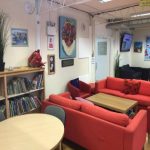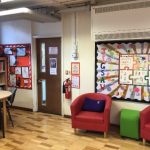At Oak View Primary & Nursery School, writing is taught every day for approximately 1 hour. A carefully planned genre map ensures that children are exposed to a wide range of text types throughout the year. Each writing unit follows a structured sequence of lessons, referred to as the ‘Phases of Writing’.
Phases for Writing
- The teacher introduces the genre, shares the Steps to Success and WAGOLL, and teaches the key features of the genre that children are working towards.
- Teachers should immerse children in the genre and text through engaging activities, including drama, to prepare for the final piece.
- Teachers must plan and teach logically sequenced lessons that develop the skills needed for the writing goal, refer to assessment statements to meet year group standards, and provide opportunities for extended writing and editing with developmental feedback.
- Teachers must plan and teach lessons where children plan, draft and edit pieces of writing that build towards their final piece.
- The teaching sequence should lead to an independent final piece in the studied genre, which children can be proud of, display, share with parents, or use as WAGOLL examples for the next year group.
- Once per half term, work is published either for display or to take home.
A WAGOLL is developed from the stimulus text to help students recognise and replicate key features in their own writing. Non-fiction units are also taught using a high-quality WAGOLL, which may be based on a stimulus text or linked to another curriculum area.
W – What
A – A
G – Good
O – One
L – Looks
L – Like
Modelling in primary English lessons is essential for providing students with high-quality examples of writing. It helps to clarify expectations, demonstrate key writing skills, and highlight the features of different genres. Through clear, structured models, pupils gain a deeper understanding of what successful writing looks like, which in turn enables them to apply these techniques in their own work. By observing the teacher’s thought process and approach to writing, students can develop confidence in their abilities, improve their skills, and ultimately achieve higher standards in their own writing.
Grammar and Punctuation
Grammar and punctuation knowledge and skills are taught throughout English lessons, with a focus on integrating them into the genres of writing being studied to reinforce their connection to the intended writing outcome. These skills are carefully mapped out across year groups to ensure comprehensive coverage and progression. Teachers may also dedicate standalone lessons to specific grammar and punctuation skills when they feel the class needs extra support to deepen their understanding or consolidate their abilities.
Spelling and Handwriting
At Oak View Primary & Nursery School, we follow the Little Wandle phonics programme for Key Stage 1 spellings, ensuring that students develop strong foundational spelling skills through a systematic approach. For Years 3-6, we use Spelling Shed, an engaging platform that supports the progression of spelling skills across these year groups. Additionally, handwriting is introduced from Year 1 using the Letterjoin scheme, where students begin to learn fully cursive writing. This approach ensures consistency and supports the development of legible, fluent handwriting as they progress through the school.
Click here to access Letterjoin at home.
Click on the links below to read useful information about how we teach writing at Oak View Primary & Nursery School.
Year 2 Long Term Planning Example
- Year 2 Long Term Planning Example (79.57KB)
What is the ‘Expected Standard’ (EXS) at the end of each Key Stage?
Click here to find out more about the expectations at the end of KS2 (Year 2).
Click here to find out more about the expectations at the end of KS2 (Year 6).
Speaking and Listening
At Oak View Primary and Nursery School, we aim for all children to:
- feel confident and valued when they express themselves through the spoken word;
- respect and value all languages;
- learn through discussion with others;
- listen to, evaluate and respect the opinions of others;
- become competent listeners and speakers.
Organisation for Speaking and Listening
Through recognising that talk has equal status with other areas of the English curriculum, speaking and listening activities are planned for. Group work is an effective way of encouraging children to listen and respond to each other whilst using language for different purposes. Planning for talk in a range of formal and informal situations will encourage children to use different dialect forms, including Standard English, in appropriate contexts. Resources should be provided to promote and enhance speaking and listening opportunities. These may include listening areas, story sessions, whole class discussion times, collaborative group work across the curriculum, role play and drama and games.
Whole Class Reading in KS2
What is it?
In KS2 we enjoy Whole Class Reading as an approach to developing our reading skills. Each half term, each year group explores and enjoys a high-quality text. These are books from a wide range of authors from across the world and spanning different time periods in history. Many of the texts link to our history and geography curriculum and reflect the diversity of our school.
During the Whole Class Reading session, a section of the book is read. This could be by the teacher who is modelling character voices, intonation, expression and how to observe the punctuation to make sense of the text. Children are encouraged to read aloud in front of their peers in a safe environment; everyone is encouraged and supported to ‘have a go’.
There are many skills we develop through this shared reading activity. It is adult directed yet there are plenty of opportunities for children to lead the discussion. It is the class discussions that deepen the children’s understanding of the characters and plot and unpick the meaning of new vocabulary.
There are opportunities for whole class discussion, partner talk activities and also independent thinking time to respond to the text. These sessions are inclusive and empowering for the children- every single child is engaged and can access the text whatever their reading ability.
There is much teacher modelling of the thinking process and how to use evidence from the text to justify their responses. Children are challenged through questioning and making further connections. The following skills are taught explicitly during the sessions:
- Vocabulary development
- Making predictions
- Sequencing
- Summarising information
- Inference
- Developing empathy
- Retrieval skills
These skills are transferrable and support the children in becoming independent learners in all areas of the curriculum.
Why do we do it?
There are many advantages associated with using this approach to developing reading comprehension skills and reading for pleasure across KS2. Some of these include:
- All children engaged and motivated to enjoy a book.
- All children exposed to high-quality, challenging and exciting books.
- Pupil confidence develops in reading aloud.
- Vocabulary development that is transferred and evident in pupils’ writing across the curriculum.
- Children actually read lengthy texts and enjoy the whole book.
- Sessions are focused on the teaching and modelling of reading skills.
- Inclusive for SEN pupils who are exposed to different sentence structures and high-level vocabulary in the selected whole class reading texts.
- Focus on developing reading comprehension skills and not simply decoding. (Focus groups may receive further support to ensure they become fluent readers.)
- It is fun for all- teachers, and pupils enjoy the experience.
What the children say…
“We read really exciting books and finish the whole book together!”
“I learn lots of new words that I can use in my writing.”
“We go on a journey as a class and really get to know the characters.”
“It makes me feel like a real reader; I read books now that I thought were too hard for me.”
“I like reading now and sometimes feel brave enough to read aloud in front of my friends.”
“I like discussing what we’re reading- it helps me understand the story.”
“I am confident enough to say what I think and how I feel about the story.”



